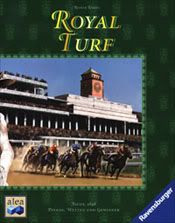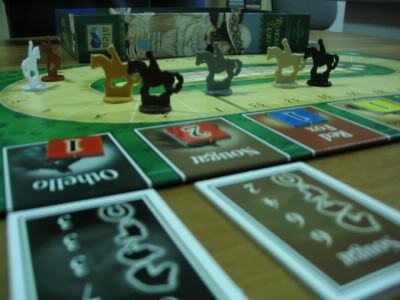
Players take the role of gentlemen and ladies spending a day at the races in Ascot at the turn of the 19th century. Each player wagers on the horses. Once the bets are placed, the races take place. The players then get to decide who wins the race by moving the horses based on a die roll. However, it’s not that simple, as any player may move any horse he wishes. Players cooperate to move a horse bearing a common wager towards the finish line, or conspire against horses that other players have backed. The whole exercise usually ends up as a raucous affair, with players chanting for the symbol that they need on the die to turn up.
As always, alea’s production values for this little game are excellent. The small single-fold board is linen-finished. The seven little horses are very nicely done. The single die that drives the race is of the wooden variety. All of the chits are of thick cardboard. All in all, it’s a beautiful package for a fairly low price point. You won’t be disappointed.
The only problem is that Royal Turf was never given an English release. However, the components are language independent, and an excellent English translation is available on Boardgamegeek. There is also a reported reprint of the game by Face2Face Games in 2005. As of this writing, there is no definitive word on the form that the new release will take.
The Game
There are seven horses in the game, each with a name matching the horse’s color. Just for fun, these are their names from memory: Earl Grey (grey), Albino (white), Nougat (dark brown), Sahara Wind (beige), Caramello (errr… caramel?), Red Fox (red) and the interestingly-named Othello (black). Each horse has three race cards. These race cards are shuffled together and placed in a stack face down. Cards are then drawn and placed face up beside the name of the horse on the board until all the horses have had a card drawn and placed (duplicates are set aside for the next race). These cards determine how far each horse will run based on the symbol result on the race die. As the cards are placed, the horses are also placed on the track. First horse with a race card drawn gets pole position, the rest follow.
Based on the revealed race cards, players bet on the horses. Each player may place three bets in each race, two single bets and a double bet. Each bet must be placed on a different horse. The bets are open – everyone can see who has bet on what horse. Players place bets in turn until all three bets have been made. The bets are for that particular horse finishing in the top three (the payout positions). The more players that bet on a horse that pays out, the less that horse pays out. So, maximum payout occurs when a horse with a single bettor finishes first. Of course, that rarely happens, as you will see later. There are no limits on the number of players that may bet on a horse.
Once all bets have been placed, the horses are off!
Players take turns rolling the six-sided race die and moving the horses. The race die bears four symbols: a horsehead (three times), a jockey’s cap, a saddle and horseshoe. Each horse’s race card bears the four symbols and a number from one to fifteen beside each symbol. The number is the number of spaces that the horse will move on the result of the die.

So, the player rolls the die and gets a symbol. He then gets to choose which of the seven horses to move. Some horses move further than other horses given the same symbol. In addition, all the seven horses must move before a particular horse may move again. Thus, it behooves the player to use his race die result wisely. He can simply move the horse he double-bet on, but if the symbol he rolled will have that horse poking along for just a couple of spaces, he may want to use the result to move an opposing horse if that result will also have that horse trotting along disinterestedly. This at least gives someone else who bet on the same horse a chance to roll a better result and move the horse along at a faster clip.
Each horse has a personality. For example, Earl Grey is a notorious sprinter. This lazy equine pokes along one space at a time if a horsehead result is applied to him. However, one or two of the other symbols startle him into moving anywhere from eight to fifteen spaces. So, players who bet on Earl usually try to move him using a non-horsehead result as early as possible. Otherwise, one of the other players will use a horsehead (which appears 50% of the time) to make Earl sleepwalk for one more turn while his opponents whiz by. In contrast, Othello is a workmanlike, persistent steed. Horseheads have him moving seven spaces on all three of his race cards, while most of his other results have him plodding along at three or five spaces. He’s a dependable creature, Othello, if a bit safe and boring. This being a Reiner game, we can be assured that the horses are mathematically balanced in some way.
Eventually, three of the horses will cross the finish line. There’s a payout table on the board which dictates how much each of the payout horses wins for the players who bet on them, depending on how many players actually bet on them as previously noted. Double bets pay out double. Once all payouts are made, the used race cards are set aside, and new race cards are set out for the second race.
There are three races. In the third and final race, all payouts are doubled (double bets are thus quadrupled). The player with the most cash at the end of the game wins!
Strategy
What strategy? It’s a light and fluffy game! Well, yeah, but it’s a REINER light and fluffy game. That means that there are still excruciating decisions to be made. First off, when betting, do you bet in a crowd, thus reducing your payout should the horse place, but ensure that you’ll have help getting the horse to the finish line? Or do you go it alone or with as few players as possible to maximize your payout and hope that you can outwit your opponents?
It’s risky to bet on sprinters like Earl Grey and Albino alone, as the other players can dump an easily-rolled horsehead on them to make them plod along. It’s less risky to go it alone on a workmanlike horse such as Othello and Caramello since it’s harder to roll up the symbol that makes them slowpokes. Counter programming is also essential, as ideally you’d like to have as many results of the die be useful to you, either by moving your own horses or screwing your opponents’ horses.
Once the race is in progress, look for the best possible play on each horse. Sometimes, you won’t really have a choice, such as when there’s only one horse that hasn’t moved and you’re up, but that situation rotates among the players. Most of the time, you’ll get options. As noted earlier, move your sprinters as early as possible, even if it’s not their “bat out of hell” result, because any result is better than a one-space jaunt. Horses like Othello are defensive plays, since you can dump almost any result on them. Therefore, it’s good to have at least one bet on a sprinter, and one bet on a safe horse. Save your double bet for last and play it based on where everyone else played their bets. I don’t normally use the double bet on a sprinter, but that’s just me. The daring double bet on the enigmatic Earl Grey. You can tell that he’s a popular horse.
Reviewer’s Tilt
I enjoy Royal Turf a lot. It’s a light game that still has some interesting decisions. It’s not Euphrat & Tigris, but you can pull it out with almost any crowd and it’s got a decent shot at being a hit. I’m not too fond of playing it with five or six, as the chaos gets so bad that it’s hard to get anything done solo, especially with the sprinters, but it’s great with four. I consider Royal Turf as one of the great gateway games, even better than Settlers or Ticket to Ride. With its betting component and its tactical application of a random result (which is driven by the betting in the first place), it introduces newbies to the concept of games with much less luck than they are accustomed to. The coming reprint will allow more players to experience just how good a gateway game Royal Turf is.
1 comment:
There is one other bit of "strategy" that one can employ, which is to try to pick a set of horses that lets you do something useful with as many different die facings as possible. For example, picking one horse that sprints on a saddle, one that sprints on a jockey's cap, and one that gallops on the horse head. That way, if you have the pick of the field on your turn, you can better your position with any roll but a...well, whatever the other symbol is.
Post a Comment